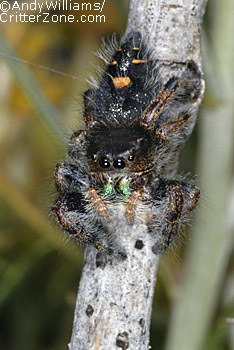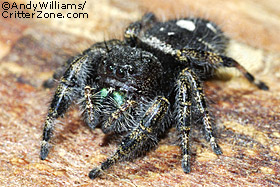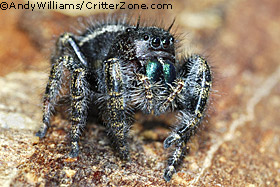| |
|
Jumping Spiders, Salticidae, Salticids
|
Jumping spiders, Salticids, or Salticidae, are the largest family of spiders. They are of small or medium size, with short, chunky bodies and stout legs furnished with two tarsal claws. These curious spiders are found on plants, logs, fences and the sides of buildings. They are likely to attract attention because of their peculiar appearance and behavior. Their short, beefy legs, bright colors, conspicuous eyes, and quick jumps are quite different from that of other spiders.
Jumping spiders appear to have a nervous, yet purposeful way about them. At times it seems they observe the observer as much as the opposite!
Salticid bodies are typically covered with hair or scales, and many species are brightly colored, even iridescent. In certain members of this family, the body is longer and somewhat ant-like in appearance. |
 Jumping spider, Salticidae, Salticid
Jumping spider, Salticidae, Salticid
|
| Members of the jumping spider family are easily recognized by the characteristic arrangement of their eyes as well as the relative size of the different pairs of eyes. Jumping spider eyes occupy the entire length of the cephalothorax (united head and thorax) and form the outline of a quadrilateral area called the ocular quadrangle. The anterior (front) eyes are large and are located on the vertical face. The anterior median (middle) eyes are very large. The posterior (rear) median eyes, generally called the small eyes, are so small they can be difficult to see. They're located in front of the posterior lateral eyes, sometimes called the dorsal eyes, forming a transverse row distinct from them. The eyes of jumping spiders form three rows. Their eye makeup is well suited for daylight vision; or in other words, they're diurnal. In a small group of genera, represented by Lyssomanes, the anterior lateral eyes are situated behind the anterior median eyes. This arrangement forms a second row of eyes; therefore the eyes of these spiders are in four rows, each row consisting of two eyes. |
| Jumping spider males and females are roughly the same size but often differ greatly in appearance via the color and form of their hair. In many cases, the males have peculiar bunches of hairs on their front legs. During mating rituals, some Salticidae males dance for the females, as well as assuming fancy yoga poses and holding their legs extended sidewise or over their heads. Their ornamental hair tufts are displayed in this effort, hopefully attracting a mate. |
 Jumping spider, Salticidae, Salticid
Jumping spider, Salticidae, Salticid
|
| Jumping spiders are fearsome little ambush predators with excellent vision, stalking their prey and leaping on it unsuspecting. They can move sidewise or backwards easily. In size relative to distance, their leaps are amazing at up to forty times their own body length. Jumping spiders spin a tether or "rappelling" line which allows them to leap from a vertical surface to catch a nearby flying insect and return quickly to the same launching surface. |
 jumping spider with prey, hunting, eating
jumping spider with prey, hunting, eating
|
 jumping spider with prey, hunting, eating
jumping spider with prey, hunting, eating
|
Salticids don't construct webs for catching prey, but they do use webbing for nests to hide in winter or when molting or laying eggs. Their nests are sac-like in form, composed of several envelopes, and usually have two openings. Salticidae egg-sacs, or cocoons, are made within the sac-like nest. These cocoons are usually lens-shaped and suspended like a hammock from the walls of the nest. There may be several of them within the nest, but a single one is the norm.
Eggs are usually laid early in the season, and the young soon hatch. Jumping spider offspring are guarded by their mom until they take off on their own. As winter approaches, these young spiders then make their own sac-like nests to pass the winter. |
As noted above, this is one of the largest and most widely distributed of the spider families. Representatives are found in all parts of the world except the Polar Regions. About three hundred species, representing more than forty genera, are found in North America north of Mexico alone.
Andy Williams / CritterZone.com |
 Jumping spider, Salticidae, Salticid
Jumping spider, Salticidae, Salticid
|
The Jumping Spiders, Salticidae, Salticid pictures on this page are available for commercial stock photography license. All photos and text that appears on this webpage is copyrighted and may not be copied or used in any way without permission from CritterZone.
CritterZone does not specifically endorse our advertisers, or their methods. We cannot control the ads that run on our articles. CritterZone advocates humane and respectful treatment of all creatures.
Save this page:

|
|
|
|